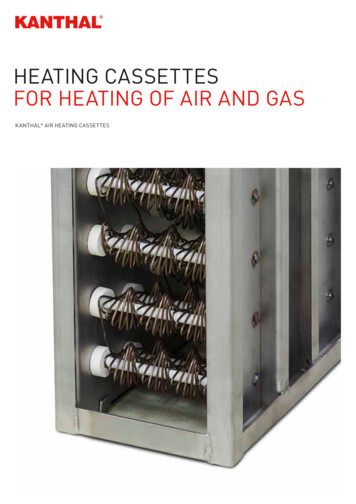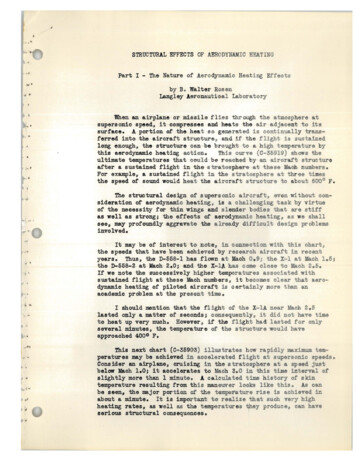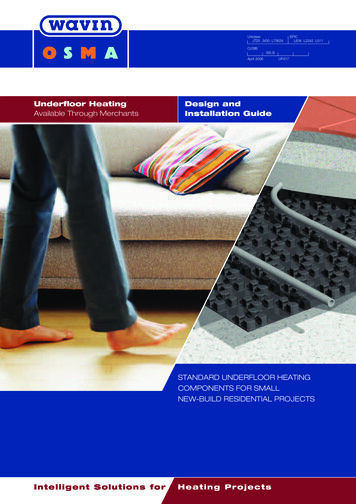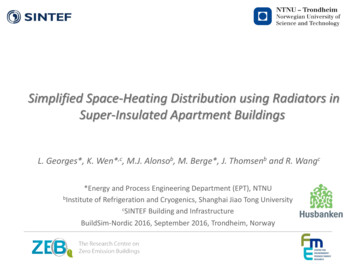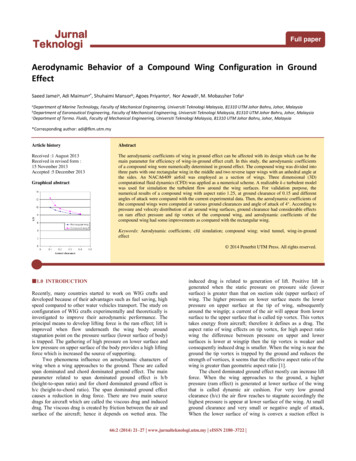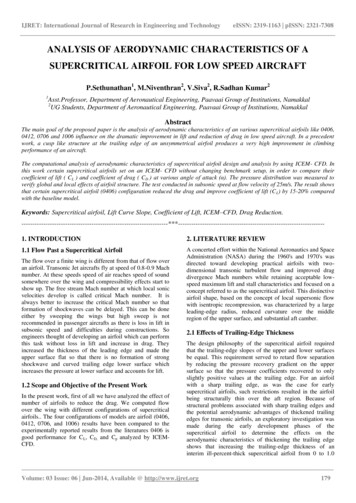
Transcription
DA RKSimplified aerodynamic heating of rocketsHans Olaf ToftDansk Amatør Raket KlubFirst edition: August 2014
IntroductionWhen a rocket travels through the air, the surface parts get heated by ”the friction with the air”. In anaivistic view, the air molecules may be thought of as small particles that hits the rocketunelastically, whereby the particle kinetic energy is converted to heat. This naivistic description ismay help the intuitive understanding of aerodynamic heating, but it is not in any way a realisticmodel of the real phenomena for three reasons:1. The air flows around the rocket, and the temperature of the airflow depends on localconditions. The surface of the rocket does not reach a temperature, but rather a temperaturedistribution.2. The aerodynamic heating does not really originate from friction, but rather from heattransfer from the heated airflow to the rocket body surface, and this heat transfer from theairflow to the surface of the rocket is not perfect.3. The surface heating is a dynamic process, where the heat capacity of the surface introduces alag in the temperature of the surface with respect to that of the flow.In the following, a simplified surface temperature calculation based on a semi empirical method, isoutlined. The method is based on [1], but extended to cover stagnation points and two dimensionalflow.Table of ContentsIntroduction.1The basic method.2Heat balance.2Boundary layer temperature.3Composite skin temperature profile.4Limitations of the method.4Extension of the method.5Recovery factor.5Heat transfer coefficient.6Skin here parameters.12Properties behind a normal shock.17Author: Hans Olaf ToftPage 1
The basic methodThe skin temperature of the rocket depends on the net heat transfer into the rocket surface, and theheat capacity of the rocket surface. Since this depends on local conditions, an exact solution of thetemperature distribution requires a full three dimensional thermodynamic calculation of vastcomplexity. It is however reasonable to assume that the lateral (along the rocket body) temperaturegradient is much smaller than the transversal (through the skin) gradient. It is thus reasonable toneglect the lateral heat flow completely. In this way the temperature at any station along the rocketsurface can be calculated independently, and these calculations can then be combined into a fulltemperature profile.Note that the description of the basic method is more or less a rewrite of the correspondingdescription in [1].Heat balanceThe heat flux (energy pr. unit area pr. unit time) from the surrounding air into the skin of the rocketbody may be expressed as:Q̇ 1 h(T B T S )Where TB is the temperature of the boundary layer and TS is the temperature of the surface of therocket. The heat transfer coefficient h has been determined experimentally by Eber [2].It is assumed that Q1 is the dominant contributor of heat flow into the skin and other sources aretherefore neglected.The rocket looses some heat however due to radiation. The radiation loss may be expressed as:Q̇ 2 ϵσ T S 4where 5.67*10-8 W/m2/K4 is the Stefan-Boltzmann constant and ϵ is the emissivity of the skin.During a time interval dt, the heat balance for the skin temperature can be written as:G dT S dt ( Q̇ 1 Q̇ 2 ) dT SG h T S ϵσ T S ⁴ hT BdtWhere G is the ”skin heating capacity” [J/m2/K], the product of the specific heat of the skinmaterial, the density of the skin material and the thickness of the material:G c ρ τFor an object that flies at constant velocity, the term dT S / dt 0 over time, and the skin reaches anequilibrium temperature determined by:hT S ,eq ϵ σ T S , eq ⁴ hT B ϵ σ T S , eq ⁴h (T B T S ,eq )Author: Hans Olaf ToftPage 2
Boundary layer temperatureWhen the flow is isentropically brought to rest, the temperature of the flow will be the so calledstagnation temperature. This mimics the situation at the nose cone apex, as for the rest of the rocketbody, the flow will be brought partially to rest by means of skin friction, and the boundary layertemperature will be somewhat lower than the stagnation temperature.The stagnation temperature (also known as the total temperature) Tst relates to the free streamtemperature Tfs and velocity Vfs in the following way:T st T fs V fs ²2Cpassuming that the specific heat capacity at constant pressure - Cp - is independent of temperature. Asthis is not entirely true, a slight correction may be necessary at high velocities.Stagnation temperature rise [K]Stagnation temperature rise40003000Constant CpVariable Cp2000100000500 1000 1500 2000 2500 3000Velocity [m/s]The boundary layer temperature relates to the stagnation temperature in the following way (bydefinition):K T B T fsT st T fsK is known as the temperature recovery factor. K was experimentally determined by Eber [2] forconical bodies. Eber found that for cones with vertex angles of 20 – 50 degrees, a value of K 0.89may be used over the entire velocity range. The boundary layer temperature rise may then beexpressed as:(T B T fs ) K (T st T fs ) K (V fs ²)2C pEber empirically modeled the heat transfer as:h (0.0071 0.0154 β)k 0.8RlHere, k is the thermal conductivity of air, l is a characteristic length - defined by Eber as the lengthof the cone, R is the Reynolds number and β is the vertex angle of the cone (in radians).Substituting for the Reynolds number yields:Author: Hans Olaf ToftPage 3
h (0.0071 0.0154 β)1l0.20.8(ρ fs u fs )k0.8μwhere µ is the dynamic viscosity of air.Composite skin temperature profileThe simplified method may be used to calculate the skin temperature at several stations of a nosecone, then combining them to a full temperature profile. This is straightforward, assuming that eachstation is located an a cone surface that tangentiates the nose cone at the station. The only questionis which reference length to use. According to [1], there is no general consensus of what l is, andsometime half the length of the cone is used.For composite temperature calculations, the somewhat conservative approach of using the surfacelength of the tangent cone, from its projected apex to the station of interest will be suggested for l assuggested in [3].Limitations of the methodThere are several limitations of this method. The applicable altitudes may not exceed 130000 ft (43km). Changes in the atmosphere properties may be significant at higher altitudes, but as ρfs thendecays rapidly, extrapolation to higher altitudes may be justified.Also the method is based on measurements within a limited range of Reynolds numbers (2*10⁵ 2*10⁶), and extrapolation outside this range may be required during application of this method.The emissivity ϵ is 1 for a black body, but the value for real rocket skin may not be known. In [1],a value of ϵ 0.4 is assumed, but it is also noted that radiation losses are small compared to theaerodynamic heating and the use of a fixed ϵ is justified, even if the value is not fully correct.Furthermore, the method implicitly assumes that the heat conduction within the skin material isinstant, so that the temperature may be considered uniform within the skin. Although the heatconduction may be much better for solid materials – and especially for metals - than for gases, thedifference may not be so prominent for composite materials. This may drive the need forintroducing a purely empirical ”shortening factor” basing the calculation on a virtual skin thickness,smaller than the real skin thickness. For good conducting materials like aluminum, the ”shorteningfactor” may be almost 1, but for composite materials, a smaller value may be required. This leads toanother problem: Composite materials will start to ablate when exposed to high temperatures. Theablation process is often followed by charring of the material thus providing the combination oftemperature reduction, higher emissivity and higher temperature working range. Naturally, ablationwill affect the validity of the skin temperature calculations.Finally, the outlined method does not cover the case of β π / 2 and it does not directly cover thetwo dimensional flow around the fins.Author: Hans Olaf ToftPage 4
Extension of the methodThe most severe restriction of the basic method is that it is limited to 20o 50o. Simplyextending the range down to 0o is likely to overestimate the skin temperature, while extending to90o is likely to underestimate the skin temperature. Overestimating the skin temperature at smallvalues of is not a serious problem as this typically corresponds to a station far from the apex,where the skin temperature is less critical. The real issue, from a designers point of view, is thetemperature of the apex region, where the flow is stagnant. In this region, one can use the stagnationtemperature as an upper bound, but this may be too conservative.Another issue from the designers point of view is the heating of the fins, especially at the leadingedges, where the wall thickness tend to be small.In the general case, only two things have to be determined in order to solve the aerodynamic heatingequationGdT S h T S ϵσ T S ⁴ hT BdtThe recovery factor K must be determined for the actual flow situation, and so must the heattransfer coefficient. The skin capacity G has the same definition regardless of the skin is that of acone, a fin or a stagnation point.Recovery factorAt the nose cone apex, the conditions must resemble that of a stagnation point, and the boundarylayer temperature TB is assumed to equal stagnation temperature Tst hence K 1.For cone angles approaching zero, the flow may be assumed to pass freely, hence the recovery mustapproach zero.Although both assumptions seem fair, they are oversimplifications. At the apex – or even in the caseof a flat plate – the air flow moves around the obstacle, and despite the ”stagnant like” conditions,the recovery factor remains below 1. At cylindrical conditions ( 0o ), there is still a boundarylayer with a temperature gradient. The recovery factor has some correlation with the skin friction,and can not be assumed to be zero.In general, the recovery factor is a function of the Reynolds number, the Mach number and thePrandtl number of the flow situation. For air, a Prandtl number of 0.7 may be assumed asrepresentative, thus reducing the recovery factor to be a function only of local Mach and Reynoldsnumbers.For flow over a flat plate, corresponding to the fin of a rocket, the Mach number has very littleinfluence on the recovery factor, and the Reynolds only separates the cases of laminar and turbulentflow:{K 3 Pr 0.89 for turbulent flow Pr 0.84 for laminar flow}At the fins, the flow will be turbulent in any realistic case, and a value of K 0.89 may be assumed.The condition separating laminar or turbulent flow is:Author: Hans Olaf ToftPage 5
{ρu L u L6 ν 10 for turbulent flowμR e lok ρu L u L6μ ν 10 for laminar flow}Where µ and ν are the dynamic respectively the kinematic viscosity of the air and ρ is the density ofthe air at the distance L from the nosecone. There is some controversy about the number 10⁶ astransition may occur unpredictally at any Reynolds number in that order.For the flow around the nose cone, the story is slightly different. For small values of and stationsfar from the apex, the flat plate model may be an acceptable approximation. Ebers measurements ofrecovery factors on cones show a systematic relation with and a slight negligible variation withthe Mach number. Knowing that Eber made his measurements around the critical ReynoldsNumber, it is interesting to see that the measurements on cones with low values of low Machnumbers approach K 0.84, while they approach K 0.89 at higher Mach (and Reynolds) numbers.Since the difference is only about 5%, it is justifiable to ignore the difference between turbulent anlaminar flow and simply assume that the universal value of K 0.89 is valid for 40 deg. Forlarger values of there is a slight correction of 10% pr degree:{K 0.890.89 0.001(β 40deg)for β 40 degfor β 40 deg}Ebers Recovery factors for cones. From [3]Heat transfer coefficientThe heat transfer coefficient may be determined from steady state measurements, if the boundarylayer temperature and emissivity is known.h ϵ σ T S , eq ⁴(T B T S , eq )If the radiation loss is ignored, there is no heat transfer between the skin and the flow, and thetemperature on the skin reaches the adiabatic stagnation flow temperature:Author: Hans Olaf ToftPage 6
T ad (1 γ 1M fs ²)T fs2Where Mfs the free stream Mach number.The adiabatic stagnation flow temperature thus represents the upper boundary for the skintemperature.For rockets, the steady state conditions are unlikely to occur, and there will be a net flux of energybetween between the skin surface and air flow. The heat transfer coefficient h relates to the Nusseltnumber in the following way:Nu hlkwhere the reference length l is a representative physical dimension of the obstacle.Compared with Ebers empirical expression for h, an empirical expression for the Nusselt numberfor cones can be stated:Nu (0.0071 0.0154 β) R0.8epresumably for turbulent flowFor flat plates, the Nusselt Number may be expressed as [4]{3Nu 0.664 0.8R e3 Pr 0.591 R0.8e0.037 R e Pr 0.0329 R efor laminar flowfor turbulent flow}using the atmosphere properties at an ”average” temperature ofT avg T fs 0.5(T skin T fs ) 0.22(T ad T fs )The expressions for cones and flat plates follows the same expression for turbulent flow, except fora scale factor. It may be convenient to merge the expressions into:Nu Nu flat plate Γ shape{}1for flat plates(β in degrees) 0.07βfor cones 0.0058β 0.13 0.12eThe conversion factor for cones can be seen below. It is reasonable that the factor should limit at afactor of 0.5 at low values of β, which corresponds with Ebers model at its stated 20o lower range.Γ shape Nusselt number conversion factor from flat plate to cone10.8Γ0.6Eber equationGamma0.40.200102030405060708090 100βAuthor: Hans Olaf ToftPage 7
Even though it is not directly mentioned, Ebers model presumably covers the case of turbulent flowonly. There is no reason to believe that the laminar flow Nusselt number model for flat plates shouldnot apply also for cones, and the shape conversion should therefore apply for both flow regimes.For the nose cone apex, the shape may be approximated with a sphere of diameter D. Here thestream conditions are considered to be subsonic, even in supersonic flow, as the flow will besubsonic behind the normal shock wave. The heat transfer coefficient may be expressed as [5]:kNuh νsk C sk R esk[]WhereC 3u0[ 1 0.252 M 0 ² 0.0175 M 0 ⁴ ]DC 2 2u0DFor a sphere of diameter DFor a wire of diameter D in cross flowν is the kinematic viscosity of airu0 is the free stream velocity [m/s]k is the thermal conductivity of airM0 is the free stream Mach number if 1. Otherwise it is the Mach number behind a normal shock.Index sk indicates that properties are calculated at the skin wall temperature.The property[Nu R esk][ ][[ ] [is derived from charts in reference [5]:( ) ][ ]( ) ][ ]TTNu 0.464 6.86 10 2 sk 8.54 10 3 skT0To R e sk2TTNu 0.640 6.67 10 2 sk 8.17 10 3 skT0ToR e sk2( )( )Pr0.80.4Pr0.80.4For wire in crossflow 0 Tsk /T0 2For sphere 0 Tsk /T0 2Where T0 is the free stream temperature if the free stream Mach number 1. Otherwise it is theTemperature behind a normal shock.Skin gradientA drawback of the original method is that it is primarily aimed at metallic skin materials with goodthermal conduction, justifying the assumption that the calculated skin temperature is present alongthe entire wall thickness of the skin. For composite materials, this assumption may not hold, due tothe poorer heat conduction of the material. The method can be improved by allowing a temperaturegradient within the skin.If the exterior side of the skin is at a temperature of TS and the interior side of the skin is at atemperature of Ti then there is an internal heat flux within the skin ofQ̇ i λτ (T S T i )The heat flux into the skin isAuthor: Hans Olaf ToftPage 8
Q̇ Q̇ 1 Q̇ 2 Q 1 h (T B T S )The assumption of uniform skin temperature is reasonable when the interior ”heat transfer” is muchbetter than the heat transfer from the boundary layer to the skin:λ 1hτNow, assume that some amount of heat has entered the skin material. The has caused a temperaturerise of TS at exterior side of the skin and of Ti at the interior side of the skin. The skintemperature calculation assumes uniform temperature however, and will result in a value of̂ S ΔTΔ T S Δ T i Δ T S (1 x τ )22It is clear, that if the calculation of Δ ̂T S had been done with half the wall thickness (or halfthermal mass), it would reach the double value – or in general:ΔT Sτ̂ δ τ Δ ̂T S (1 x τ )2δThis means that Δ ̂T S Δ T S whenδ (1 x τ )2Aplying this ”shortening factor” δ to the wall thickness τ will compensate for a non uniformtemperature distribution within the skin. It can be seen that δ 1 corresponds to the case of uniformtemperature distribution while δ 1/2 corresponds to the case of very poor heat conduction.On this basis, the use of a purely empirical shortening factor is suggested: λ2 e h τδ 2AblationA simple ablation model can be added, by assuming that ablation happens at a known and constanttemperature, Tablate [K], and at a known and constant heat of ablation Hablate [J/kg]. Furthermore it isassumed that ablation does not affect the boundary layer in any way.In this case, the skin temperature does not exceed the ablation temperature, and at the ablationtemperature all the heat flux into the skin is spent evaporating the material. As such, the wallthickness τ will reduce while the skin temperature is larger than the ablation temperature:dT SdτG h(T B T S ) ϵ σ T S ⁴ H ablate ρdtdt{dT S 0 for T S T ablatedtwithdτ 0 for T S T ablatedt}It follows thatAuthor: Hans Olaf ToftPage 9
dτ dt{h(T B T S ) ϵ σ T S ⁴ H ablate ρ0for T S T ablate ;h(T B T S ) ϵ σ T S ⁴ 0for T S T ablate ; h(T B T S ) ϵσ T S ⁴ 0}Charring may be modeled by setting ϵ 1 .Author: Hans Olaf ToftPage 10
Literature1. NACA Technical Note No. 1725. ”Determination of transient skin temperature of conicalbodies during short-time, high speed flight”. Hsu Lo, Langley Aeronautical Laboratory,October 1948.2. ”Experimentelle Untersuchung der Bremstemperatur und des Wärmeüberganges aneinfachen Körpern bei Überschallgeschwindikeit”. G. R. Eber, Peenemünde, November1941.3. NACA Technical Note 1724. ”A study of skin temperatures of conical bodies in supersonicflight”. Wilber B. Huston, Calvin N. Warfield, Anna Z. Stone. Langley AeronauticalLaboratory, October 1948.4. ”Aerodynamic heating”. MECH 448 lecture slides. Queen's University, Department ofMechanical and Materials Engineering.5. NACA Technical Note 3513. ”Heat transfer at the forward stagnation point of blunt bodies”.E. Reshotko and C. B. Cohen. Lewis Flight Propulsion Laboratory, July 1955.6. ”Heat and Mass Transfer”. E. R. G. Eckert and R. M. Drake, Jr. McGraw-Hill BookCompany, Inc., international student edition.7. US STANDARD ATMOSPHERE SUPPLEMENTS, 1966 (60deg N, July)Author: Hans Olaf ToftPage 11
AppendixAtmosphere parametersThe local speed of sound may be expressed as:c γPγ RT for an ideal gasρ Μγ is the adiabatic index 1.4 for an ideal gasρ is the local density of airP is the local pressureT is the local absolute temperatureM is the molar mass of the air 0.0289645 kg/molR is the universal gas constant 8.3145 J/mol/KIf the speed of sound cref is known at some reference temperature Tref then this can be used tocalculate c at temperature T:c (T ) c ref TT refThen Mach number is the velocity of the flow divided by the speed of sound:M ucThe following properties have been curve fitted from tabulated values of reference [6].Air density [kg/m³]Air density versus temperature43.532.521.510.50TabulatedModel05001000 1500 2000 2500 3000Temperature [K]ρ(T ) 360 0.114 T T100 K T 2500 KC p (T ) 1030 0.24T 6.85 10 4 t² 4.33 10 7 T³ 9.45 10 11 T⁴Author: Hans Olaf Toft100 K T 2500 KPage 12
Air Cp versus temperatureAir Cp [ J/kg/K]20001500TabulatedModel1000500005001000 1500 2000 2500 3000Temperature [K]Air dynamic viscosity [kg/s/m]μ(T ) 1.00 10 5 1.47 10 9 T 1.68 10 6 T100 K T 2500 KAir dynamic viscosity versus 0E-0053.00E-0052.00E-0051.00E-0050.00E 000TabulatedModel05001000 1500 2000 2500 3000Temperature [K]Air kinematic viscosity [m²/s]ν(T ) 7.24 10 6 5.30 10 8 T 7.95 10 11 T² 8.07 10 15 T³100 K T 2500 KAir kinematic viscosity versus el3.00E-0042.00E-0041.00E-0040.00E 00005001000 1500 2000 2500 3000Temperature [K]Author: Hans Olaf ToftPage 13
k (T ) 1.29 10 2 2.43 10 5 T 3.39 10 9 T² 1.88 10 3 T100 K T 2500 KAir k versus temperatureAir k atedModel6.00E-0024.00E-0022.00E-0020.00E 00005001000 1500 2000 2500 3000Temperature [K]Pr (T ) 0.815 5.31 10 4 T 7.13 10 7 T² 3.69 10 10 T 3 7.10 10 14 T⁴100 K T 2500 KAir Prandtl Number versus temperature1.20E 0001.00E 000Air 010.00E 0000500 1000 1500 2000 2500 3000Temperature [K]The air temperature T [K] versus altitude s [m] is curve fitted from [7]:{ 3 7287.954 5.03015 10 s 1.2859 10 s²225.15T [ s] 242.057 2.33854 10 3 s 7.08133 10 8 s² 2 7 12 534.104 3.95468 10 s 6.0177 10 s² 2.71838 10 s³ 3 8 13867.12 9.78603 10 s 5.75164 10 s² 8.81316 10 s³Author: Hans Olaf Toft0m s 10.0km10km s 23km23km s 42km42km s 81.5km81.5km s 120km}Page 14
Air temperature versus altitude450400Temperature [K]350300250200150100500020000400006000080000 100000 120000 140000Altitude ASL [m]The free stream Mach velocity c [m/s] versus altitude s [m] is curve fitted from [7]:{ 3 8 12340.234 3.05528 10 s 6.35237 10 s² 2.91745 10 s³0m s 10km300.810km s 23kmc [ s] 97.435 5.121 10 2 s 2.469 10 6 s² 5.269 10 11 s³ 4.089 10 16 s⁴23km s 42km 3 7 12 17287.23 6.725 10 s 4.103 10 s² 6.824 10 s³ 3.371 10 s⁴42km s 82km 1 6 11 16 8698.8 3.91cdot 10 s 6.29 10 s² 4.41cdot 10 s³ 1.13 10 s⁴ 82km s 120kmMach velocity versus altitude450400Mach velocity 000 120000 140000Altitude ASL [m]Author: Hans Olaf ToftPage 15}
The air pressure P [mBar] versus altitude s [m] is curve fitted from [7]{ 14 9 4exp (4.43165 10 s³ 2.28553 10 s² 1.14097 10 s 6.91509)P [ s] exp( 2.28179 10 14 s³ 3.34063 10 9 s² 2.84655 10 4 s 8.73033)exp(4.44813 10 14 s³ 1.13434 10 8 s² 7.62651 10 4 s – 15.5981)0m s 25km25km s 75km75km s 120km}Air Pressure [mBar]Air Pressure versus altitude1.00E 0041.00E 0031.00E 0021.00E 0011.00E 0000100000150000Altitude ASL [m]The air density ρ [kg/m³] versus altitude s [m] is curve fitted from [7]{ 18 13 11 5exp(4.88158 10 s⁴ 1.808 10 s³ 2.432 10 s² 9.693 10 s 0.1922) 0m s 25kmρ[ s] exp( 6.034 10 19 1.035 10 13 5.746 10 9 s² 2.21 10 5 s 0.396)25km s 75km 18 13 8 3exp( 1.004 10 s⁴ 4.440 10 s³ 7.137 10 s² 4.773 10 s 121.84) 75km s 120kmAir density versus altitude1.00E 0011.00E 000Air 50000Altitude ASL [m]Author: Hans Olaf ToftPage 16}
Properties behind a normal shockThe atmosphere properties behind a normal shock relates to the free stream values in the followingway:P 0 2 γ M 2fs (γ 1) P fsγ 1Static pressureT 0 [2 γ M 2fs ( γ 1)][(γ 1) M fs ² 2] T fs(γ 1)² M fs ²Static temperatureρ0( γ 1) M fs ²ρ fs (γ 1) M ² 2Densityfs[P t0(γ 1) M fs ² P tfs ( γ 1) M fs ² 2] [T t0 1T tfsM 0 (γ 1) M 2fs 22 γ M fs ² (γ 1)Author: Hans Olaf Toftγγ 1(γ 1)2 γ M fs ² (γ 1)]1γ 1Total pressureTotal temperatureMach numberPage 17
Simplified aerodynamic heating of rockets Hans Olaf Toft Dansk Amatør Raket Klub First edition: August 2014 DA RK. Introduction When a rocket travels through the air, the surface parts get heated by "the friction with the air". In a naivistic view, the air molecules may be thought of as small particles that hits the rocket

